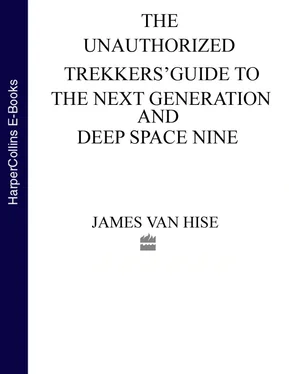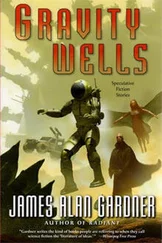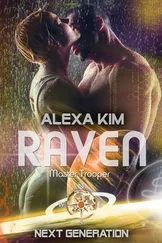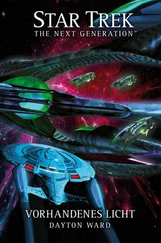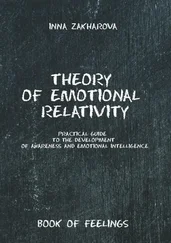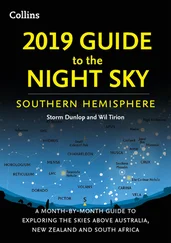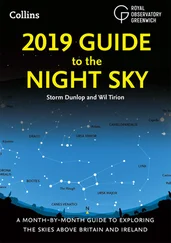Another new character, eventually to be promoted to the post of chief engineer, is Geordi La Forge. The role is named as tribute to the late Star Trek fan George LaForge, a cerebral palsy sufferer whose long survival was attributed to his strong identification with the show. Geordi contributes to the tradition of a multiethnic cast in Star Trek . He is blind, but due to the advanced technology of the twenty-fourth century, can see by means of an electronic visor linked with his nervous system. He can even see visual ranges inaccessible to most human beings. Geordi is a sincere, likable, confident man with slight insecurities. He always perseveres, communicating freely with others. The opposite of Picard, he affects an informal approach to life and is not hung up on protocol. Actor LeVar Burton, best known as the young Kunta Kinte in the classic miniseries Roots , plays the role. This character was reportedly created by David Gerrold.
A KLINGON ON THE BRIDGE
The biggest shock in The Next Generation’ s crew roster was Worf … a Klingon. Since Kirk’s heyday, peace has finally been negotiated between the Federation and the Klingon Empire. Negotiations were underway at the time of the events of Star Trek III: The Search for Spock , a fact referred to by Commander Kruge in that film. This was further developed in Star Trek VI: The Undiscovered Country . The two spheres of influence strive to get along and have established some mutual trust. There are no other Klingons in Starfleet.
Worf is unique. He was raised by humans after his family was killed in the massacre of their outpost during a surprise Klingon attack—an event that still haunts him. He is like Spock in that he is the product of two cultures, a warrior Klingon dedicated to his own culture but tempered by exposure to human ideals. Worf was added after the pilot for The Next Generation and does not appear in “Encounter at Farpoint.” For a time, he would be little more than a grouchy guy standing in the background recommending aggressive action. He would be featured in more and more episodes, eventually opening up a window on the fascinating world of the Klingons. The six-foot-five Michael Dorn was cast as Worf. Dorn was born in Liling, Texas, but raised in Pasadena, California, just minutes away from Hollywood.
With the cast set, The Next Generation got under way. Creator Gene Roddenberry handed the executive producer’s reins over to Paramount’s Rick Berman.
CREATIVE CONFLICTS
D. C. Fontana signed on as story editor, but soon left, unhappy with the treatment received by her script “Encounter at Farpoint.” Sadly, the episode kicked off the new series with less than a bang. Fontana’s initial story received a forced graft of Gene Roddenberry’s “Q” subplot and the two concepts didn’t cross over, much less merge. Instead of a genuine, two-hour movie, audiences received two separate stories. Like Star Trek: The Motion Picture , “Encounter at Farpoint” moved slowly, too enamored of its own special effects. It was no surprise that Gene Roddenberry’s name was on the screenplay. Roddenberry said, “In the first Star Trek [series], I rewrote or heavily polished the first thirteen episodes so that Mr. Spock would be the Mr. Spock that I had in mind. This was enormous labor, and then this began to catch on and we got some good writers on this.
“In Star Trek: The Next Generation I rewrote thirteen episodes. I don’t want to act out a big ‘I did this, I did that,’ but as far as the basic original writing, I had to do that again, with few exceptions. It is the way episodic television is. Now as the year’s gone on,” he said during the first season, “I’ve found some good people and I hope to find more. We got some good writing in the old series, and we’ve had some good writing in the new series. Most of the writing comes from very few, very good people who labor hard. Very often they are staff people.”
Special effects for the first season were provided by Industrial Light and Magic, but they soon proved too expensive. Other effects teams were sought out. With a per episode budget of over a million dollars, The Next Generation was a major gamble for Paramount. They had to use the budget to the best of their ability.
GROWING PAINS
The first season of The Next Generation was erratic. The actors had yet to settle into their roles, and the scripts, often rewritten by Gene, were uneven. Controversy ensued when both D. C. Fontana and David Gerrold felt they had contributed to the development of the series concept and neither received credit. Gene never acknowledged them. In fact, in regard to Gerrold, he went so far as to comment that “… Gerrold [had] been condemning the show, constantly. I had him on staff for many, many months, [and] he never wrote an episode we could shoot.” He had, but Roddenberry refused to approve it. This contributed to their professional break.
Fontana is harder to dismiss. She worked on a total of four scripts for the first season of The Next Generation . She left following a particularly ugly encounter with Roddenberry when he supposedly asked her to write an entire script and attach his name as cowriter so that he could meet the studio’s demand for his writing a certain number of scripts during the first season. When she refused because it would be a violation of Writer’s Guild rules, Roddenberry claimed that he was the one who got her into the business (which wasn’t true) and felt that she was ungrateful for not doing him this favor.
The dispute between Gene, Fontana, and Gerrold was settled behind the scenes for a monetary sum. No on-screen credit was given. Some regard this as more important than a lump sum payoff, because without screen credit there is no public acknowledgment of what a writer created. In spite of the settlement, Roddenberry may well have felt that he’d won.
The second season of The Next Generation showed marked improvement. Changes were evident. Jonathan Frakes now sported a beard. Some viewers, unimpressed by the first season, now use the sight of a clean-shaven Riker as their cue not to watch a rerun.
TWO NEW SECOND-SEASON ADDITIONS
Doctor Pulaski, ably played by Diana Muldaur, a veteran guest star of the original Star Trek , joined the cast in the second season. Despite Muldaur’s fine acting, this character didn’t work. Perhaps the problem was that the crusty, no-nonsense Pulaski seemed to be a female “Bones” McCoy. The character provided much-needed friction on the bridge, but never really came to bear on the plots much.
Another new character also came onboard in the second season, although she may have been there all along for purposes of continuity. Guinan is a mysterious alien woman of great age who functions as bartender and freelance counselor in the Enterprise’ s open lounge, Ten Forward. She serves synthehol, a marvelous brew whose mildly intoxicating effects can be shaken off at will. Guinan’s background is intentionally shrouded in mystery. Although not featured on a weekly basis, she is a recurring presence.
THE SHAPE OF THINGS
By this time, Gene had developed a stable of writers he could trust. His production team was learning to work the way Gene worked. On future plans for The Next Generation , Roddenberry stated, “We have a lot in store, and a lot of things we want to talk about. We can no longer claim we’re brave because we have mixed races. Twenty-three years ago, that was very exciting. We had women in jobs other than secretaries. People were saying, ‘My God, how far can they go!’
“Now we want to talk about hostage situations. I am amazed to see the hostage (takers) treated as bad guys always. Many of these people have legitimate complaints. The world is not as simple as we lay it out—good guys here, bad guys there. I am very concerned and want to find a way to get into the fact that most of the warfare and killing going on in the world is going on in the name of religion: organized religion. Not that I’m saying that there are not great plans and that we are not part of some great thing, but it is not the type of thing you see preached on television. I don’t hold anyone up to ridicule. My mother is a good Baptist and she believes in many great things. I cannot sit still in a series of this type and not point out who’s killing who in the world.”
Читать дальше
